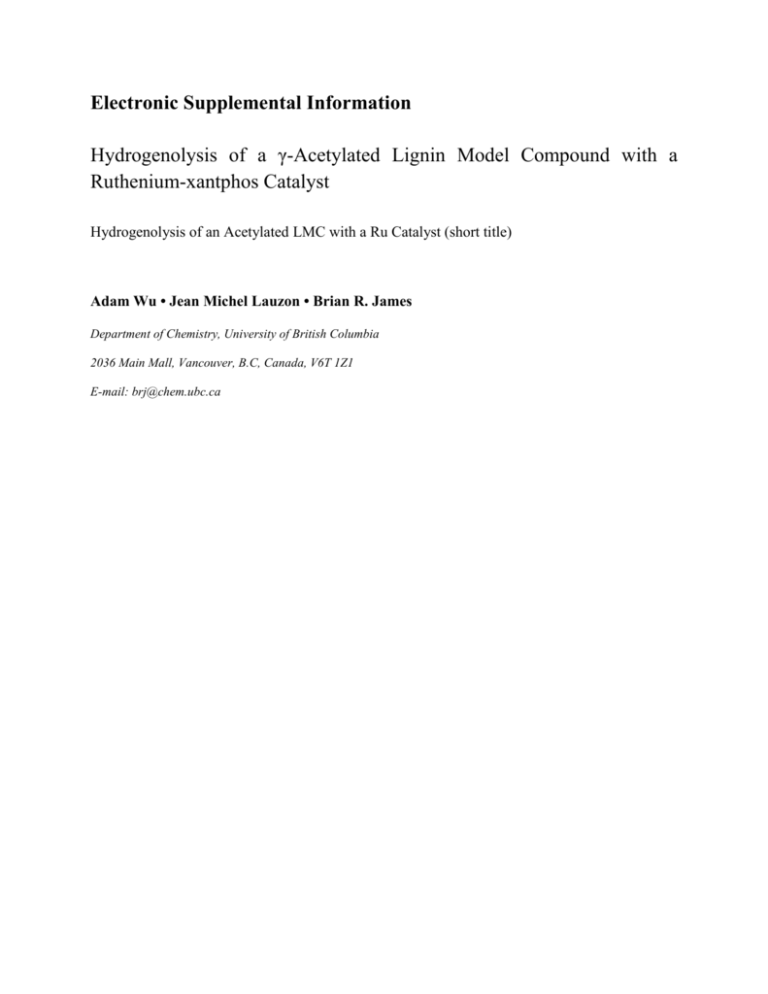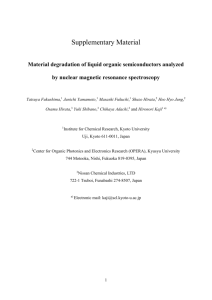NMR Spectra - Springer Static Content Server
advertisement

Electronic Supplemental Information
Hydrogenolysis of a γ-Acetylated Lignin Model Compound with a
Ruthenium-xantphos Catalyst
Hydrogenolysis of an Acetylated LMC with a Ru Catalyst (short title)
Adam Wu • Jean Michel Lauzon • Brian R. James
Department of Chemistry, University of British Columbia
2036 Main Mall, Vancouver, B.C, Canada, V6T 1Z1
E-mail: brj@chem.ubc.ca
Contents
NMR Spectra ............................................................................................................................ S3
Fig S1. .................................................................................................................................. S3
Fig S2. .................................................................................................................................. S4
Fig S3 ................................................................................................................................... S5
Fig S4. .................................................................................................................................. S6
Fig S5. .................................................................................................................................. S7
Fig S6. .................................................................................................................................. S8
Fig S7 ................................................................................................................................... S9
Table S1 ............................................................................................................................... S9
Fig S9. ................................................................................................................................ S11
Fig S10 ............................................................................................................................... S12
Quantum Chemical Calculations............................................ SError! Bookmark not defined.
Fig S8 ................................................................................. SError! Bookmark not defined.
Mass Chromatogram .............................................................................................................. S13
Fig S11 ............................................................................................................................... S13
Table S2 ............................................................................................................................. S14
Hydrogenolysis of LMC with Ru* in Non-Protic, High-Boiling, Polar Solvents ................. S15
Scheme S1 .......................................................................................................................... S15
Table S3 ............................................................................................................................. S15
S2
7.5
7.0
6.5
6.0
5.5
6.16
5.0
4.5
4.0
3.5
Chemical Shift (ppm)
3.0
2.5
2.0
1.5
1.0
0.5
0
154.08
149.37
190.13
127.10
110.90
110.18
30.52
8.0
2.00
123.93
8.5
0.99
56.22
56.10
1.08 1.01
6.93
6.91
7.64
7.63
7.61
7.56
4.42
3.97
3.95
NMR Spectra
180
160
140
120
100
80
Chemical Shift (ppm)
60
40
20
0
Fig S1 1H (300 MHz) and 13C{1H} (75 MHz) NMR spectra for 3,4-dimethoxybromoacetylbenzene (1) in CDCl3.
S3
3.95
3.93
3.89
5.29
6.92
6.91
6.85
6.84
7.60
7.69
7.66
8.0
7.5
7.0
2.00
6.5
6.0
5.5
9.13
5.0
4.5
4.0
3.5
Chemical Shift (ppm)
3.0
2.5
2.0
1.5
1.0
0.5
0
180
160
127.91
147.66
153.89
149.28
193.36
72.07
122.43
120.89
114.75
112.22
110.21
122.85
8.5
5.15
56.19
56.08
55.97
1.00 1.01
140
120
100
80
Chemical Shift (ppm)
60
40
20
0
Fig S2 1H (300 MHz) and 13C{1H} (75 MHz) NMR spectra for 1-(3,4-dimethoxyphenyl)-2-(2-methoxyphenoxy)ethanone (2) in
CDCl3.
S4
3.94
3.91
3.85
180
160
Fig S3 1H (300 MHz) and
propanone (3) in CDCl3.
3.0
2.5
2.0
1.5
1.0
0.5
0
55.91
5.0
4.5
4.0
3.5
Chemical Shift (ppm)
63.85
56.23
56.08
128.17
140
13C{1H}
5.5
84.56
6.0
3.24
3.21
3.19
5.38
5.42
6.5
2.08 6.08 3.05 0.94
123.75
121.27
118.39
112.39
111.06
110.23
7.0
4.09
5.40
6.96 6.91
6.83
6.83
6.81
4.07
6.89
6.86
7.5
1.00
154.05
150.51
149.31
147.05
8.0
5.17
195.12
8.5
6.99
7.73 7.61
7.61
7.77
7.76
1.00 0.97
120
100
Chemical Shift (ppm)
80
60
40
20
0
(75 MHz) NMR spectra for 3-hydroxy-2-(2-methoxyphenoxy)-1-(3,4-dimethoxyphenyl)-1-
S5
3.94
3.92
3.77
2.04
5.93 3.00
3.15
118.13
Fig S4 1H (400 MHz) and
propanone (4) in CDCl3.
140
13C{1H}
2.5
2.0
1.5
1.0
0.5
0
121.08
123.90
160
128.14
154.00
150.43
149.17
147.02
171.04
194.21
180
3.0
20.92
5.0
4.5
4.0
3.5
Chemical Shift (ppm)
56.21
5.5
56.09
6.0
55.90
6.5
80.40
7.0
1.09 1.06
112.74
111.17
110.29
7.5
0.98
64.75
5.62
5.61
5.61
5.60
5.19
123.46
8.0
4.68
4.67
4.65
4.64
4.53
4.51
6.91
8.5
6.94
6.93
6.89
6.88
6.86
6.81
7.67
6.98 7.67
6.96
7.85
1.00 1.03
120
100
Chemical Shift (ppm)
80
60
40
20
0
(100 MHz) NMR spectra for 3-acetoxy-2-(2-methoxyphenoxy)-1-(3,4-dimethoxyphenyl)-1-
S6
7.5
5.21
5.20
1.91 3.06
7.0
1.01
6.5
6.0
5.5
1.00
5.99 2.99
5.0
4.5
4.0
3.5
Chemical Shift (ppm)
3.0
2.5
2.0
1.5
1.0
0.5
0
180
160
Fig S5 1H (400 MHz) and
propene (9) in CDCl3.
13C{1H}
112.96
110.03
56.10
99.97
125.15
140
120
56.17
121.34
129.20
125.85
143.42
151.07
148.82
153.47
189.20
158.10
121.77
55.96
8.0
4.71
4.70
3.94
3.94
3.86
8.5
6.91
6.89
7.84
7.84
7.82
7.82
7.64
7.64
7.26
7.08
7.06
0.95 0.96
100
Chemical Shift (ppm)
80
60
40
20
0
(100 MHz) NMR spectra for 2-(2-methoxyphenoxy)-1-(3,4-dimethoxyphenyl)-1-oxo-2-
S7
180
160
5.0
4.5
4.0
3.5
Chemical Shift (ppm)
140
120
100
Chemical Shift (ppm)
3.0
2.5
2.0
1.5
1.0
0.5
0
80
60
40
20.71
5.5
29.46
6.0
55.96
55.84
55.67
6.5
2.03
56.14
55.57
7.0
3.17 3.17 3.09 3.18 3.08 3.11 1.02 1.00
142.98
140.30
131.26
123.89
126.96 120.73
120.59
112.87
112.39
112.24
110.60
110.49
110.12
101.91
7.5
2.65
2.43
2.42
2.37 2.39
2.88
6.97
3.05 9.16
153.51
151.21
149.59
148.68
148.56
8.0
192.68
8.5
3.73
3.63
3.87
3.91
7.20
7.20
6.96
6.94
6.85
6.70 6.82
6.68
7.79
7.78 7.26
8.06
8.05
8.04
8.03
1.001.01
20
0
Fig S6 1H (400 MHz) and 13C{1H} (100 MHz) NMR spectra for cyclobutyl(diketo)tetramer (10) in CDCl3. H2O was detected
qualitatively in 1H NMR spectrum (top) at δH = 1.56.
S8
Fig S7 A section (δH = 3.05-3.65) of the variable temperature (VT) 1H NMR spectra (400 MHz, benzene-d6) of 10.
Table S1 Shifts for OCH3 signals displayed in Fig S7.
Temp (°C)
25
30
40
50
60
70
80
90
3.21
3.22
3.25
3.28
3.30
3.33
3.35
3.37
Signal Shift (ppm)
3.25
3.33
3.40
3.27
3.34
3.41
3.29
3.35
3.43
3.31
3.37
3.45
3.34
3.38
3.47
3.36
3.40
3.48
3.38
3.42
3.50
3.40
3.43
3.51
3.44
3.45
3.46
3.47
3.48
3.48
3.49
3.50
S9
Quantum Chemical Calculations
In addition to a VT NMR study (Fig S7), quantum chemical calculations were performed to
explore the lack of symmetry observed for 10 in solution. A series of 4 possible geometries, 2
possessing C2 symmetry and 2 with no symmetry elements, was optimized using density
functional theory (B3LYP/6-31G*); optimization to local energy minima revealed that none of
the structures contained symmetry elements, the lowest relative energy structure (3.3–5.8
kcal/mol lower than the other minima) being shown in Fig S10. This structure is one of many
orientations that do not possess C2 symmetry and is consistent with six OCH3 signals in the 1H
NMR spectrum in CDCl3 solution.
Fig S8 Optimized geometry of 10 (left) and the corresponding line drawing representation (right).
S10
8.5
8.0
7.5
7.0
6.5
6.0
5.5
5.0
4.5
4.0
3.5
Chemical Shift (ppm)
3.0
2.5
2.0
1.5
1.0
0.5
0
Fig S9 A representative example of 1H NMR spectra (300 MHz, toluene-d8) observed for the degradation of acetylated lignin
with the Ru* catalyst. The bottom spectrum was taken before the J-Young NMR tube was placed in the pre-heated oil-bath. The
top spectrum was taken (at r.t.) after the reaction was heated for 20 h at 135 °C. Notice the increase of the intensity of signals at
δH = 3.2–3.6 in the top spectrum.
S11
8.5
8.0
7.5
7.0
6.5
6.0
5.5
5.0
4.5
4.0
3.5
Chemical Shift (ppm)
3.0
2.5
2.0
1.5
1.0
0.5
0
Fig S10 1H NMR spectra (300 MHz, toluene-d8) observed for the heating of acetylated lignin to 135 °C for 20 h in the absence of
Ru*. The bottom spectrum was taken before the J-Young NMR tube was placed in the pre-heated oil bath. The top spectrum
was taken (at r.t.) after the reaction was heated.
S12
Mass Chromatogram
Below is an example of a mass chromatogram (Fig S8) from the degradation of acetylated
lignin with the Ru* catalyst. The reaction mixture was filtered through a Celite plug, diluted in
CH2Cl2, and injected into the GC/MS. This chromatogram is from the same reaction mixture as
the 1H NMR on the previous page. Table S2 shows the retention times, and the corresponding
mass fragments of the signals.
Fig S8 Mass chromatogram from the degradation of acetylated lignin with the Ru* catalyst.
S13
Table S2 Retention times and major mass fragments corresponding to the mass chromatogram in Fig.11.
Retention Time (min)
6.73
6.80
6.96
12.16
12.22
13.00
13.12
13.63
13.69
13.79
14.40
15.07
15.29
Major Mass Fragments (m/z)
105, 91, 79
121
125
211, 193
238, 207, 105
227, 125, 105
304, 292, 264
263, 253, 235, 135, 121, 105
263, 185, 79
249, 239, 221, 121, 105
instrument noise
CH2Cl2 stabilizer
79
S14
Hydrogenolysis of LMC with Ru* in Non-Protic, High-Boiling, Polar Solvents
A series of non-protic, high-boiling, polar solvents was screened for their potential as reaction
media for the hydrogenolysis of lignin using Ru*. Each solvent is capable of dissolving a range
of lignins as well as the Ru complex; toluene (which cannot dissolve lignin) is included for
reference. The screening reaction is shown with the test substrate in Scheme S1 with the results
summarized in Table S3. Based on these findings, DMF was selected as a co-solvent for the
experiments presented in the text in Section 3.3. The decrease in catalysis activity likely results
from coordinating ability of the solvents. Additionally, ortho-metalated Ru species are observed
in control experiments with DMSO and are suggestive of alternative decomposition pathways.
Scheme S1 Hydrogenolysis of a ‘dimer’ LMC used for solvent screen.
Table S3 Consumption of ‘dimer’ LMC in different solvents.
Solvent
Toluene
Dimethylsulfoxide (DMSO)
Dimethylformamide (DMF)
Dimethylacetamide (DMA)
N-Methylpyrrolidine (NMP)
1,4-Dioxane
Consumption of LMC (%)
> 95
29
52
25
19
15
S15






